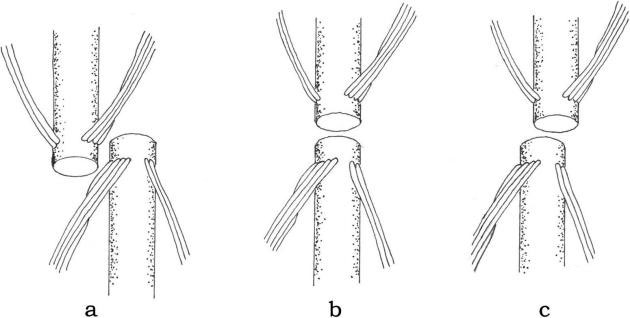Basal Bodies
A flagellum cannot be dissociated from its base, the basal body, or kinetosome. This structure has a
cylindrical form, with an average diameter of 0.2 µm and a variable height (average 0.5 µm). The wall of the cylinder is discontinuous, and consists of nine microtubular triplets tilted to the radii at an angle of 130° and interconnected by transverse desmosomes. The complete tubule A consists of 13 protofilaments and the incomplete tubules B and C have 10 protofilaments. The proximal part of the basal body contains a fibrogranular structure termed the cartwheel, composed of a longitudinal central tubule and nine series of spokes joined to the triplets. This structure seems to be present in nearly all species of algae, with variations reported mainly for the length of the basal body. While most green algae usually possess very short basal bodies (250–450 nm), those of the Prasinophyceae are often twice as long (560–690 nm). Some members of the Haptophyta, such as
Chrysochromulina, also possess very long basal bodies (850–875 nm), but this length can reach a value of 1300 nm in some Euglenophyta such as
Entosiphon.
In some Chlorophyta two structures are present in association with the proximal ends of the
basal bodies: the terminal cap and the proximal sheaths. The terminal cap is a more or less prominent
electron-dense flap located on the anterior surface of the basal body, which folds over and
covers in part its proximal end. The proximal sheath is located posterior to the proximal end of
the basal body, and can have a half-cylindrical shape or be wedge-shaped, narrow proximally,
and broad distally.
Variations in the number of basal bodies mainly reflect variations in the number of flagella. It is
possible to distinguish:
- Cells with only one basal body, carrying one flagellum; this situation is very rare and is
present in the euglenophyte of uncertain affinity, Scytomonas pusilla, and in the gametes
of the diatoms Lithodesmium and Biddulphia
- Cells with two neighboring basal bodies, forming the so-called primordial pair indicated as 2A
- Cells with numerous basal bodies
In the case of twobasal bodies, two possibilities exist: only one basal body, generally situated close to the nucleus or linked to it, possesses a flagellum, as in the spores of Hydrurus; or both basal bodies possess a flagellum. The latter is the most frequently occurring situation in flagellate algae. Most often the basal bodies are inclined towards each other, sometimes they are perpendicular, or they may also be parallel facing the same directions or antiparallel facing opposite directions. In the Glaucophyta the two basal bodies are inclined towards each other; in the Heterokontophyta they are parallel in the Chrysophyceae Mallomonas or Synura or almost perpendicular in Ochromonas, lie at an obtuse angle to each other in the Xanthophyceae and Phaeophyceae, and are inclined to each other at an angle of about 908 in the Eustigmatophyceae and Raphidophyceae; in the Haptophyta the angle between the two basal bodies can be acute or obtuse; in both Cryptophyta and Euglenophyta the basal bodies are almost parallel, while in the Dinophyta they lie at almost 1808 to each other and slightly overlap.
In the Chlorophyta the angle between the two basal bodies can vary (about 908 in Chlamydomonas, 1808 in Acrosiphonia zoid) and the couple can assume three different configurations (Figure 2.47):
- 12 o’clock–6 o’clock configuration, in which the basal bodies are in line with each other
- 11 o’clock–5 o’clock configuration, in which the basal bodies are anticlockwise rotated relative to the first configuration
- 1 o’clock–7 o’clock, in which the basal bodies are clockwise rotated relative to the first configuration

FIGURE 2.47 Schematic drawing of cruciate arrangements of basal bodies and roots of Chlorophyta. 11 o’clock–5 o’clock type (a), 12 o’clock–6 o’clock type (b), 1 o’clock–7 o’clock type (c).
The 11 o’clock–5 o’clock configuration is present in Ulvophyceae, Cladophorophyceae, Bryopsidophyceae, Trentepohliophyceae, and Dasycladophyceae, while both the 12 o’clock– 6 o’clock and 1 o’clock–7 o’clock configurations are present in the Chlorophyceae. In the case of many basal bodies, the increase in their number and the corresponding increase in the number of flagella can result from:
- A replica of each basal body of the pair, as in the stephanokont zoospore of Oedogonium
(Chlorophyceae, Chlorophyta)
Replica of the primordial pair, indicated by the formula X . 2A, as in the dinoflagellate
Phaeopolykrikos sp. (Dinophyta) where the primordial pair has undergone four replicas
(4 . 2A)- Addition of new basal bodies in the surroundings of the primordial pair without a replication
of it, indicated by the formula 2A + N; algae with four flagella, as Tetraselmis suecica
or Pyramimonas lunata (Prasinophyceae, Chlorophyta), have a formula 2A + 2N, while
algae with eight flagella as Pyramimonas octopus (Prasinophyceae, Chlorophyta), are indicated
by the formula 2A + 6N





